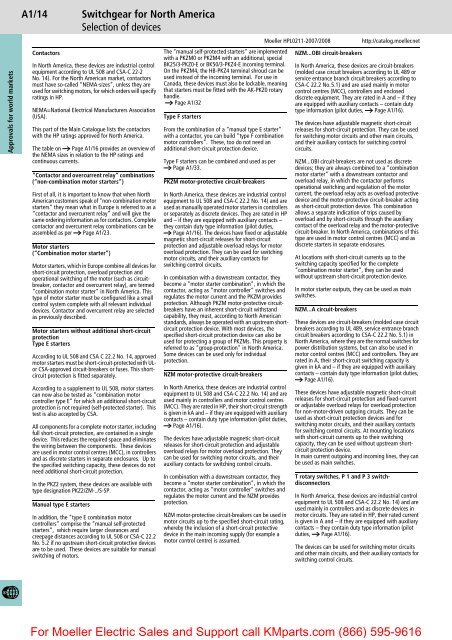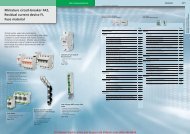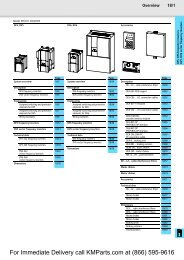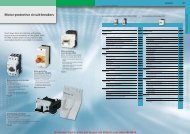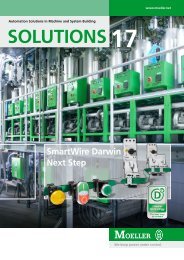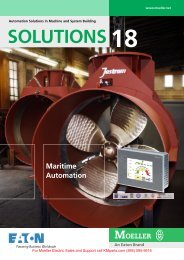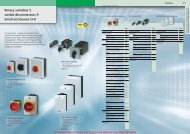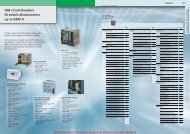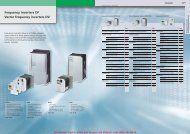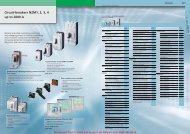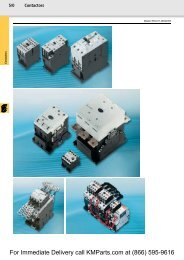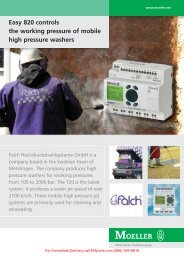Approvals and certificates - Moeller Electric Parts
Approvals and certificates - Moeller Electric Parts
Approvals and certificates - Moeller Electric Parts
Create successful ePaper yourself
Turn your PDF publications into a flip-book with our unique Google optimized e-Paper software.
For <strong>Moeller</strong> <strong>Electric</strong> Sales <strong>and</strong> Support call KMparts.com (866) 595-9616<br />
<strong>Approvals</strong> for world markets<br />
A1/14<br />
Contactors<br />
Switchgear for North America<br />
Selection of devices<br />
In North America, these devices are industrial control<br />
equipment according to UL 508 <strong>and</strong> CSA-C 22-2<br />
No. 14). For the North American market, contactors<br />
must have so-called “NEMA-sizes”, unless they are<br />
used for switching motors, for which orders will specify<br />
ratings in HP.<br />
NEMA=National <strong>Electric</strong>al Manufacturers Association<br />
(USA).<br />
This part of the Main Catalogue lists the contactors<br />
with the HP ratings approved for North America.<br />
The table on a Page A1/16 provides an overview of<br />
the NEMA sizes in relation to the HP ratings <strong>and</strong><br />
continuous currents.<br />
“Contactor <strong>and</strong> overcurrent relay” combinations<br />
(“non-combination motor starters”)<br />
First of all, it is important to know that when North<br />
American customers speak of “non-combination motor<br />
starters” they mean what in Europe is referred to as a<br />
“contactor <strong>and</strong> overcurrent relay” <strong>and</strong> will give the<br />
same ordering information as for contactors. Complete<br />
contactor <strong>and</strong> overcurrent relay combinations can be<br />
assembled as per a Page A1/23.<br />
Motor starters<br />
(“Combination motor starter”)<br />
Motor starters, which in Europe combine all devices for<br />
short-circuit protection, overload protection <strong>and</strong><br />
operational switching of the motor (such as circuitbreaker,<br />
contactor <strong>and</strong> overcurrent relay), are termed<br />
“combination motor starter” in North America. This<br />
type of motor starter must be configured like a small<br />
control system complete with all relevant individual<br />
devices. Contactor <strong>and</strong> overcurrent relay are selected<br />
as previously described.<br />
Motor starters without additional short-circuit<br />
protection<br />
Type E starters<br />
According to UL 508 <strong>and</strong> CSA C 22.2 No. 14, approved<br />
motor starters must be short-circuit-protected with ULor<br />
CSA-approved circuit-breakers or fuses. This shortcircuit<br />
protection is fitted separately.<br />
According to a supplement to UL 508, motor starters<br />
can now also be tested as “combination motor<br />
controller type E” for which an additional short-circuit<br />
protection is not required (self-protected starter). This<br />
test is also accepted by CSA.<br />
All components for a complete motor starter, including<br />
full short-circuit protection, are contained in a single<br />
device. This reduces the required space <strong>and</strong> eliminates<br />
the wiring between the components. These devices<br />
are used in motor control centres (MCC), in controllers<br />
<strong>and</strong> as discrete starters in separate enclosures. Up to<br />
the specified switching capacity, these devices do not<br />
need additional short-circuit protection.<br />
In the PKZ2 system, these devices are available with<br />
type designation PKZ2/ZM-../S-SP.<br />
Manual type E starters<br />
In addition, the “type E combination motor<br />
controllers” comprise the “manual self-protected<br />
starters”, which require larger clearances <strong>and</strong><br />
creepage distances according to UL 508 or CSA-C 22.2<br />
No. 5.2 if no upstream short-circuit protective devices<br />
are to be used. These devices are suitable for manual<br />
switching of motors.<br />
The “manual self-protected starters” are implemented<br />
with a PKZM0 or PKZM4 with an additional, special<br />
BK25/3-PKZ0-E or BK50/3-PKZ4-E incoming terminal.<br />
On the PKZM4, the HB-PKZ4 terminal shroud can be<br />
used instead of the incoming terminal. For use in<br />
Canada, these devices must also be lockable, meaning<br />
that starters must be fitted with the AK-PKZ0 rotary<br />
h<strong>and</strong>le.<br />
a Page A1/32<br />
Type F starters<br />
From the combination of a “manual type E starter”<br />
with a contactor, you can build “type F combination<br />
motor controllers”. These, too do not need an<br />
additional short-circuit protection device.<br />
Type F starters can be combined <strong>and</strong> used as per<br />
a Page A1/33.<br />
PKZM motor-protective circuit-breakers<br />
In North America, these devices are industrial control<br />
equipment to UL 508 <strong>and</strong> CSA-C 22.2 No. 14) <strong>and</strong> are<br />
used as manually operated motor starters in controllers<br />
or separately as discrete devices. They are rated in HP<br />
<strong>and</strong> – if they are equipped with auxiliary contacts –<br />
they contain duty type information (pilot duties,<br />
a Page A1/16). The devices have fixed or adjustable<br />
magnetic short-circuit releases for short-circuit<br />
protection <strong>and</strong> adjustable overload relays for motor<br />
overload protection. They can be used for switching<br />
motor circuits, <strong>and</strong> their auxiliary contacts for<br />
switching control circuits.<br />
In combination with a downstream contactor, they<br />
become a “motor starter combination”, in which the<br />
contactor, acting as “motor controller” switches <strong>and</strong><br />
regulates the motor current <strong>and</strong> the PKZM provides<br />
protection. Although PKZM motor-protective circuitbreakers<br />
have an inherent short-circuit withst<strong>and</strong><br />
capability, they must, according to North American<br />
st<strong>and</strong>ards, always be operated with an upstream shortcircuit<br />
protection device. With most devices, the<br />
specified short-circuit protection device can also be<br />
used for protecting a group of PKZMs. This property is<br />
referred to as “group-protection” in North America.<br />
Some devices can be used only for individual<br />
protection.<br />
NZM motor-protective circuit-breakers<br />
In North America, these devices are industrial control<br />
equipment to UL 508 <strong>and</strong> CSA-C 22.2 No. 14) <strong>and</strong> are<br />
used mainly in controllers <strong>and</strong> motor control centres<br />
(MCC). They are rated in HP, their short-circuit strength<br />
is given in kA <strong>and</strong> – if they are equipped with auxiliary<br />
contacts – contain duty type information (pilot duties,<br />
a Page A1/16).<br />
The devices have adjustable magnetic short-circuit<br />
releases for short-circuit protection <strong>and</strong> adjustable<br />
overload relays for motor overload protection. They<br />
can be used for switching motor circuits, <strong>and</strong> their<br />
auxiliary contacts for switching control circuits.<br />
In combination with a downstream contactor, they<br />
become a “motor starter combination”, in which the<br />
contactor, acting as “motor controller” switches <strong>and</strong><br />
regulates the motor current <strong>and</strong> the NZM provides<br />
protection.<br />
NZM motor-protective circuit-breakers can be used in<br />
motor circuits up to the specified short-circuit rating,<br />
whereby the inclusion of a short-circuit protective<br />
device in the main incoming supply (for example a<br />
motor control centre) is assumed.<br />
<strong>Moeller</strong> HPL0211-2007/2008<br />
NZM...OBI circuit-breakers<br />
http://catalog.moeller.net<br />
In North America, these devices are circuit-breakers<br />
(molded case circuit breakers according to UL 489 or<br />
service entrance branch circuit breakers according to<br />
CSA-C 22.2 No.5.1) <strong>and</strong> are used mainly in motor<br />
control centres (MCC), controllers <strong>and</strong> enclosed<br />
discrete equipment. They are rated in A <strong>and</strong> – if they<br />
are equipped with auxiliary contacts – contain duty<br />
type information (pilot duties, a Page A1/16).<br />
The devices have adjustable magnetic short-circuit<br />
releases for short-circuit protection. They can be used<br />
for switching motor circuits <strong>and</strong> other main circuits,<br />
<strong>and</strong> their auxiliary contacts for switching control<br />
circuits.<br />
NZM...OBI circuit-breakers are not used as discrete<br />
devices; they are always combined to a “combination<br />
motor starter” with a downstream contactor <strong>and</strong><br />
overload relay, in which the contactor performs<br />
operational switching <strong>and</strong> regulation of the motor<br />
current, the overload relay acts as overload protective<br />
device <strong>and</strong> the motor-protective circuit-breaker acting<br />
as short-circuit protection device. This combination<br />
allows a separate indication of trips caused by<br />
overload <strong>and</strong> by short-circuits through the auxiliary<br />
contact of the overload relay <strong>and</strong> the motor-protective<br />
circuit-breaker. In North America, combinations of this<br />
type are used in motor control centres (MCC) <strong>and</strong> as<br />
discrete starters in separate enclosures.<br />
At locations with short-circuit currents up to the<br />
switching capacity specified for the complete<br />
“combination motor starter”, they can be used<br />
without upstream short-circuit protection device.<br />
In motor starter outputs, they can be used as main<br />
switches.<br />
NZM...A circuit-breakers<br />
These devices are circuit-breakers (molded case circuit<br />
breakers according to UL 489, service entrance branch<br />
circuit breakers according to CSA-C 22.2 No. 5.1) in<br />
North America, where they are the normal switches for<br />
power distribution systems, but can also be used in<br />
motor control centres (MCC) <strong>and</strong> controllers. They are<br />
rated in A, their short-circuit switching capacity is<br />
given in kA <strong>and</strong> – if they are equipped with auxiliary<br />
contacts – contain duty type information (pilot duties,<br />
a Page A1/16).<br />
These devices have adjustable magnetic short-circuit<br />
releases for short-circuit protection <strong>and</strong> fixed-current<br />
or adjustable overload relays for overload protection<br />
for non-motor-driven outgoing circuits. They can be<br />
used as short-circuit protection devices <strong>and</strong> for<br />
switching motor circuits, <strong>and</strong> their auxiliary contacts<br />
for switching control circuits. At mounting locations<br />
with short-circuit currents up to their switching<br />
capacity, they can be used without upstream shortcircuit<br />
protection device.<br />
In main current outgoing <strong>and</strong> incoming lines, they can<br />
be used as main switches.<br />
T rotary switches, P 1 <strong>and</strong> P 3 switchdisconnectors<br />
In North America, these devices are industrial control<br />
equipment to UL 508 <strong>and</strong> CSA-C 22.2 No. 14) <strong>and</strong> are<br />
used mainly in controllers <strong>and</strong> as discrete devices in<br />
motor circuits. They are rated in HP, their rated current<br />
is given in A <strong>and</strong> – if they are equipped with auxiliary<br />
contacts – they contain duty type information (pilot<br />
duties, a Page A1/16).<br />
The devices can be used for switching motor circuits<br />
<strong>and</strong> other main circuits, <strong>and</strong> their auxiliary contacts for<br />
switching control circuits.


